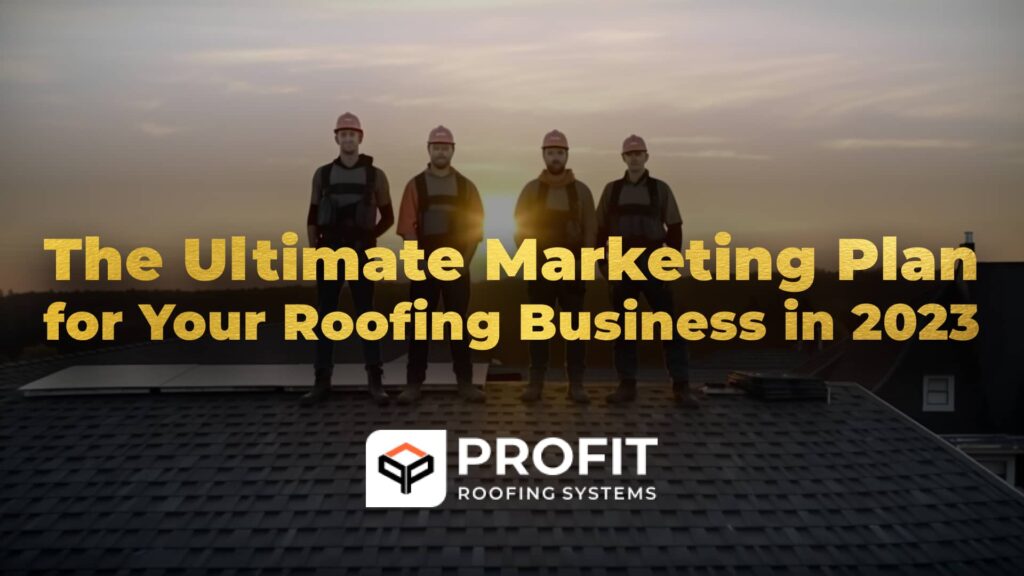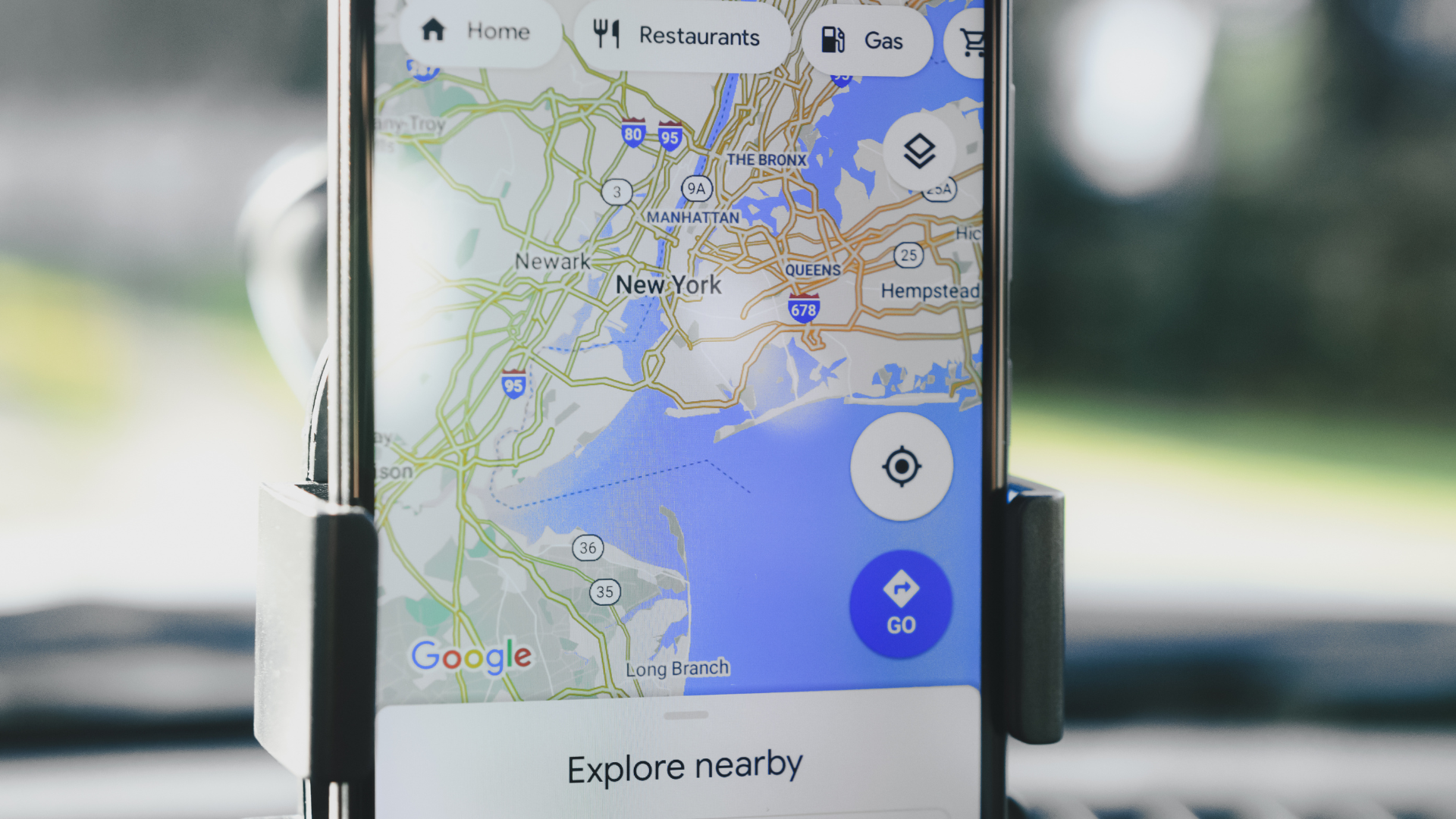If you’ve been in the roofing business for a while now, you get what it’s all about – it’s basically the survival of the fittest. So, we ask you – how fit are you?
If you’re here reading this, you’ve probably tried it all – you’ve done the groundwork (literally) – the good old door-knocking, word-of-mouth referrals, some offline advertising.
Then maybe you caught wind of some of your competitors’ online success. So, you dabbled in some online marketing. Tried a bit of Facebook, maybe scraped together a website (or not, who needs it anyway?).
You might have already tried some roofing marketing agencies, thinking they’re the experts, they might help push your business up – got burned and said to hell with them. Understandable, plenty of A-holes out there.
So, by now, you’ve had enough of it all. You want to feel that thrill of success, you want to smell the smell of money coming to you non-stop, and reap the rewards of your hard work.
It’s time to cut the bulls*** and start CRUSHING IT. This year is your year. We agree, and we’re here to show you how.
From start to finish, here you’ll find everything – and we mean everything – you need to crush your competition online and start making the big bucks. So, here it goes – the ultimate marketing plan for your roofing business in 2023.
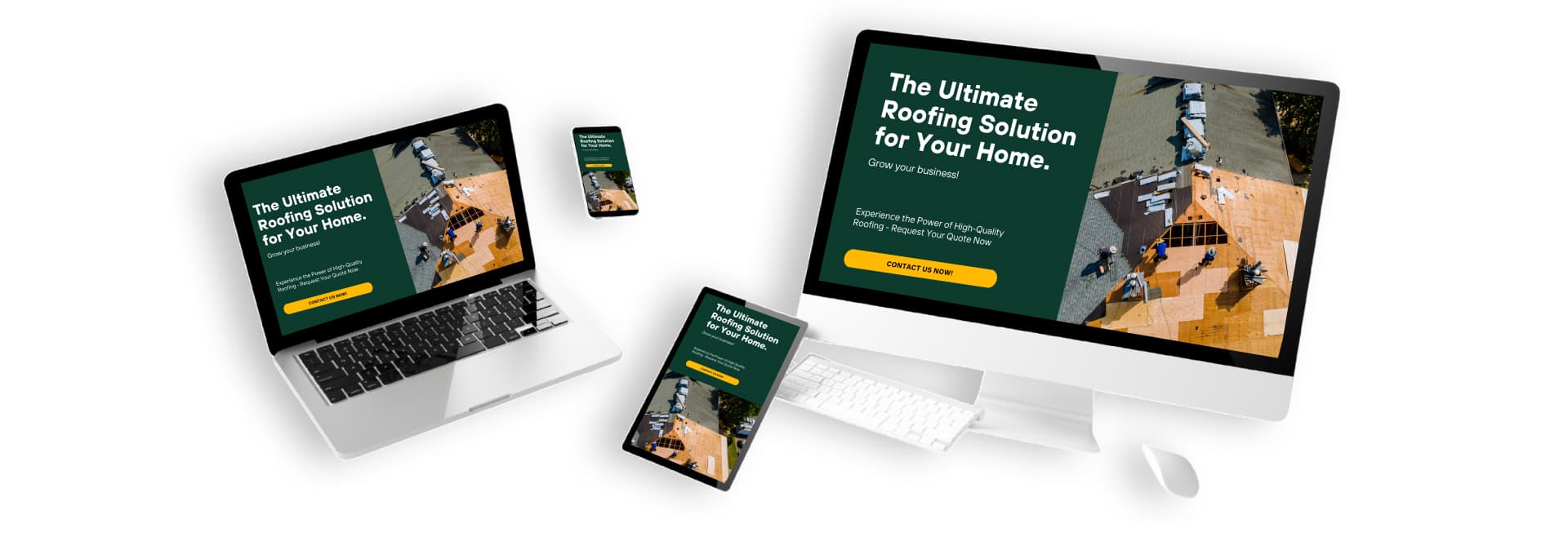
Start at the Beginning – You Can’t Go Anywhere or Do Anything Without a Website
And we don’t mean just any website. We mean a proper, highly-converting roofing website. This is the main building block of your marketing strategy, the alpha, and the omega of your success.
But in order to maximize the potential of your web and really turn it into a lead-generating machine, you can’t build just any type of website. Using some random online web builder won’t cut it if you mean business. And you do if you’re here, right?
So, what you need to do is hire a professional web designer, because these next few crucial things you won’t get by half-assing it – i.e., by using some free web building tool.
This is what makes a difference between a web that’s just there for show and a web that converts users into leads:
- A unique design that makes your users want to stay on your web, click some more, and eventually fill out the contact form and schedule an appointment.
- Convenient and easy-to-use navigation so that your users can move around effortlessly – otherwise, they’ll just leave. They don’t have the time or patience to “figure out” your web. It needs to be simple.
- Mobile-friendly/responsive design because phones have become the #1 tool we use to google and search for info. And not only phones but tablets, iPads, and other devices as well.
- Testimonials and contact forms on EVERY page. Get all the testimonials you already have on Google, Yelp, Facebook, or any other platform and incorporate them on every page of your website. You can have one page dedicated only to testimonials, but you also want at least a few of them on all other pages. They capture attention, help your users develop trust, and turn to you more easily. And this is where the contact forms come in, as well. You want to make it easy for your users to contact you and request an estimate/inspection. So, wherever they are, in whichever phase of their research and decision-making process, make sure the contact form and the call-to-action button are right there in front of them.
- Tap to call button. Imagine a user needs a roof repair quickly, grabs their phone, googles, lands on your web, likes everything they see and immediately wants to get in touch with you. That’s a lead you don’t want to miss. And you won’t miss them if you have a visible button they can simply tap and call you.
Without these key elements, your website basically doesn’t serve much of a purpose. It will simply exist, blend in with the rest of them, or even put your potential customers off because you won’t seem professional or trustworthy enough.
So, it’s best to leave it to the professionals who’ll make your website and your investment in it very worthwhile.
Now, if you’re wondering what that investment entails – how much it will cost, how long it will take, and all other details – here are your answers. Keep reading!
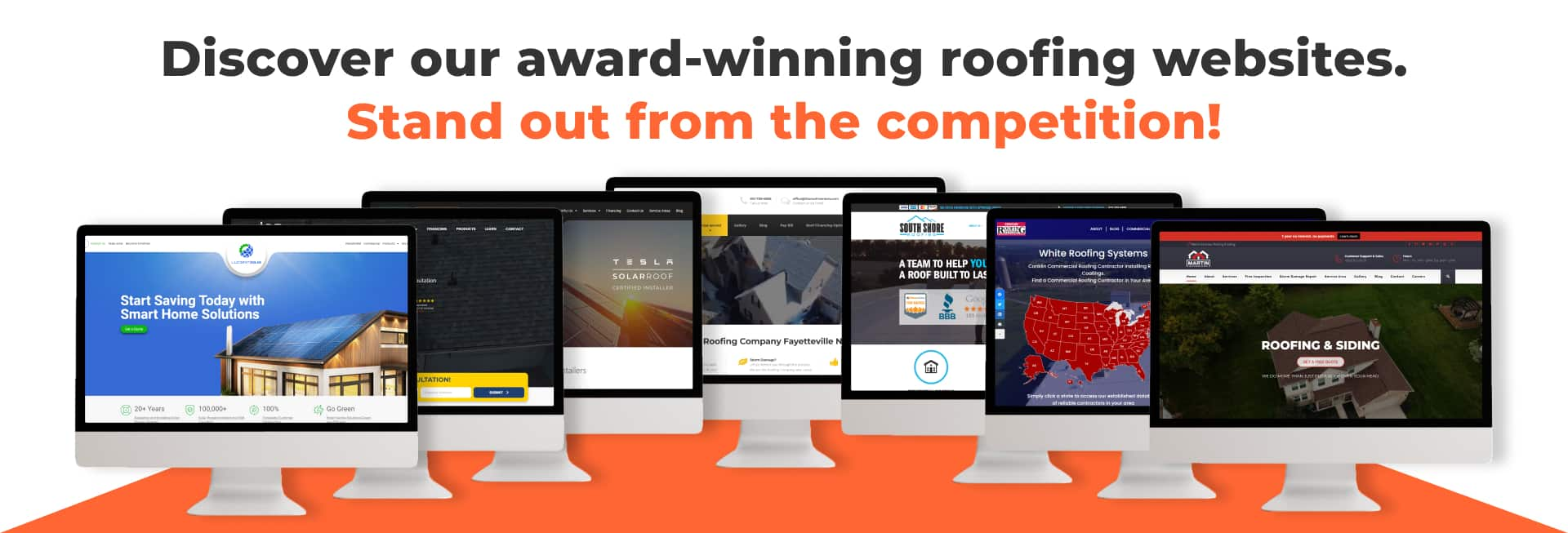
- How Much Does a Professional Roofing Website Cost?
The cost of a professional roofing website can range from a few thousand to 10 thousand dollars, depending on factors such as content creation and website design complexity. The price is influenced by whether a template or custom-made design is used. However, the upper limit for a custom-made website is around 10 thousand dollars, and there is no need for it to cost more than that.
- How Long Does It Take to Design & Build a Roofing Website?
It usually takes between 30 to 60 days to design and build a roofing website. However, the timeline can vary depending on the speed of delivery by the content creator.
Now, let’s see what you can do for your website to make it more “real”, trustworthy, and professional.
- What Materials Will YOU Need to Acquire & Deliver to Be Included in the Website?
While the professionals will deal with all the technical aspects of building your web and including all the high-converting elements, there are a few things that only you can do, i.e., deliver. And these are also CRUCIAL for your roofing website.
So, what can be so crucial and inspire trust among your users? Visual materials and proof of your work.
For a kickass roofing web, you’ll need to have photos – of you, your team, your company, your completed projects, before/after photos. Because that’s what your potential clients want to see. Real people and real results.
Then videos. If you’ve got great videos, you’re already kicking ass. These can be videos of you saying a few things about your company, way of work, introducing your team, or showing your actual work on a roofing project. These can also be video testimonials, where you talk to your satisfied clients about the work that was done. This is actually highly encouraged and users love to see them.
So, if you don’t have photos or videos – get to snapping and filming asap.
This roofing website will be the cornerstone of nearly all your future marketing efforts and will be an irreplaceable asset in itself, giving your users all the info they need, as well as inspiring trust and helping them choose you more easily.
Once You Have Your Website Good & Ready, It’s Time to Make Nice With Google
And by making nice with Google, we mean optimizing your new website so that Google grows very fond of it and puts it at the very top of its search results. This is called SEO or search engine optimization. You might have heard of it, might’ve already tried it, but nonetheless, we’re bringing you every single thing you ever wanted to know about it, including the most important ones – how much does it cost, what can you expect from it and how soon!
So, SEO – ranking on the first page of Google. Why does it even matter, you might think to yourself. Let us tell you why.
Think about it this way – what do you do when you need any kind of service or information? You probably Google it. We all do. We take our phones, type in some keywords, and voila – Google gives us the most relevant results for our search.
That’s what your potential clients do, as well. They’ll type in “roofing company near me” or “roofing company + your city/state.” And if you’re not on the first page, among those top results that pop up, all these potential clients will go to your competitors who are at the very top. And you – you basically don’t even exist for those clients at this point.
Bottom line – you need to and want to be there.
How? What do you need and what does it entail exactly? Here’s everything you need to know about a roofing SEO campaign.
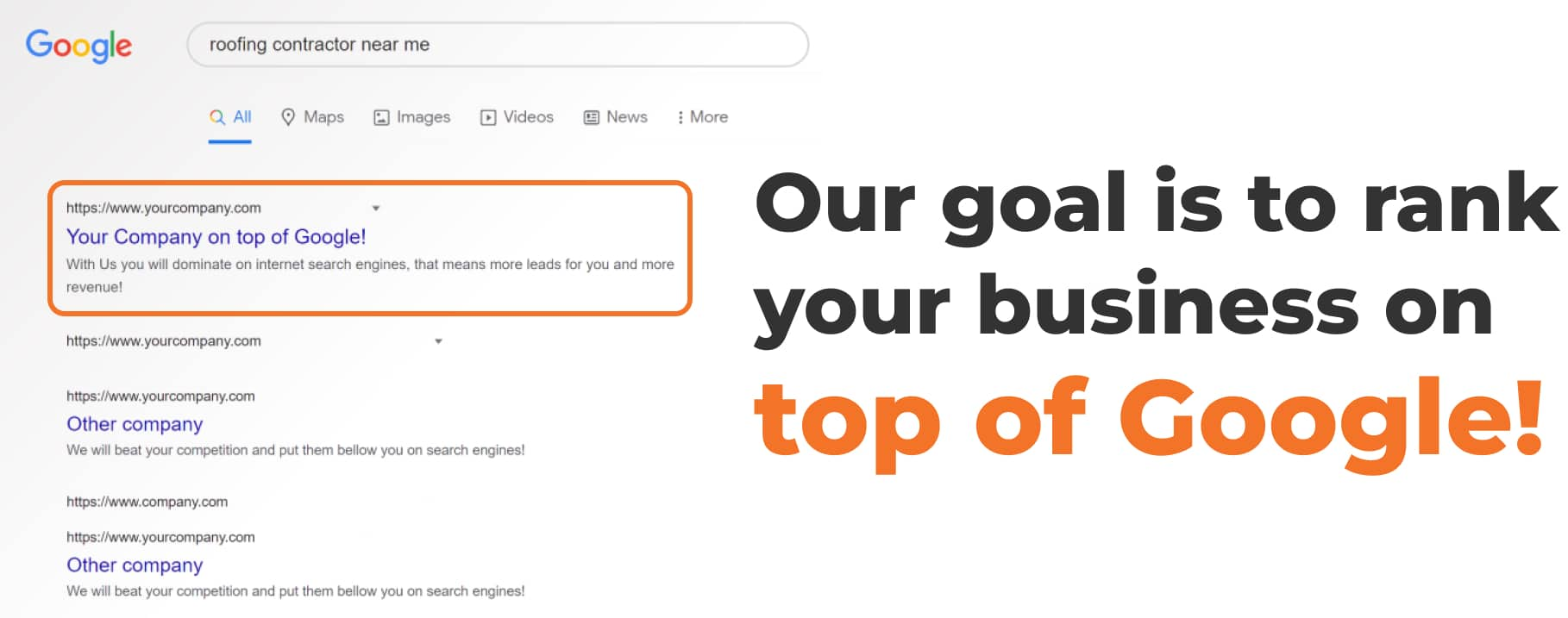
What Does SEO Optimization Entail – Main Aspects
First things first – the most important thing that needs to be done is keyword research. Without it, SEO cannot begin. So, here, as a roofer, you need to first determine the services you want to offer and rank for. Will it be only roof replacement, roof repair, roof installation, or all of it combined? Do you also offer and want to rank for commercial roofing, maybe metal roofing? This is up to you to decide, and the decision is usually based on which services are the most profitable for your company.
In addition to this, there are several general roofing keywords that we will automatically optimize for as our tests and experience show that they bring in 80% of traffic to your web. These include: roofing company, roofing contractor, roofers, roofing + [your city], roofers near me, roofing near me, and roofing company near me.
Once the keywords are determined, we move onto the actual optimization work on your web – starting with creating keyword-optimized content for the web. The content is written and optimized on two levels – the first one is the service that we are ranking for, and the second one is the location(s) of your roofing business:
o For example, we’ll write content around the keyword “roofing contractor,” which shows Google that you’re relevant for that specific service, and then we’ll include the location that you want to rank for, to show Google that you operate in this exact area, so that your website comes up in local searches – when people from your area search for a roofer.
Next, we move on to on-page optimization. This means that we’ll optimize all the elements of a specific page on your web for the same group of keywords – such as the above-mentioned “roofing contractor + location.” This keyword and its variants are implemented into the URL, meta title, meta description, alt tags (photo names), H1 (the main heading on your page), and all of the other H tags (subheadings throughout the content).
Almost equally important as your website is your Google My Business (GMB) profile. And it is the main focus of SEO in these next steps.
So, a GMB profile/listing is the first thing that shows up in local search results, i.e., when users look for services in their specific area. It shows your business on Google Maps and instantly gives your users all the info they need to reach you. We don’t even have to say it, but we will – GMB is a must have.
In addition to that, a GMB profile also signals to Google that your business actually exists in this area and that you have a physical office there. Plus, the previously mentioned, most important keywords for your roofing SEO – roofers near me, roofing near me, roofing company near me – you can rank for them only if you have a GMB profile.
And if that’s not enough – the majority of SEO leads come through none other than the GBM listing!
Now, in order to actually show up among those top listings and achieve high rankings on Google Maps (top 3), your profile needs to be fully optimized. First of all, it needs to be in the exact city/area that you want to rank for. You can’t be in one city and try to rank for another. Google cannot be fooled 😀
GMB optimization includes adding a keyword-optimized business description, a large number of geo-optimized photos (project photos, team photos, etc.), posting regularly, as well as creating citations (main, local and roofing niche citations), which are basically business listings in the local and roofing directories (e.g., Yelp, Foursquare, Porch, etc.). And finally, you need to actively collect client reviews on GMB as this is the first thing that your potential clients will see and look for.
What Do YOU Need to Do and/or Deliver Before the SEO Campaign Kicks Off?
As we’ve mentioned above, the most important thing is to know which services you want to rank for, exactly which area you want to rank for, as well as have the option to open GMB profiles for those areas. You also need to have a quality, professional website that follows Google’s best practices – for example, it loads fast and has the option to track Page Experience through the Page Speed Insights tool.
Photos – i.e., the visual elements – are very important for both the users/visitors, as well as the SEO, so that’s another thing you’ll need. Some great photos for your website, GMB profile, and all other online assets that you may have.
And finally, arm yourself with some patience as SEO is a process that takes a while – generally 6-9 months. But once it takes hold, you can expect amazing results, exposure, and increased growth. In addition to that, during this 6-month period, you might also get a few telemarketing/spam calls because, during these first months, the largest number of citations are created, so your phone number will be much more available to other parties.
How Long Does It Take to See the First SEO Results, and What Exactly Are These Results?
The answer to this question depends on factors such as competition and the size of the city or area. For example, if the roofer is the only roofing company in the city, results may appear in as little as three months. However, for most cases, it takes an average of 6-9 months.
Also, as we have already written, during the initial period, it’s important to note that many of the inquiries that come in may be spam calls or emails. These ‘bots’ have access to the phone number in multiple locations, making it easy for them to use it.
It’s also essential to handle calls from real people effectively. These potential customers may have opened several pages and are actively searching for the best option for their roof. Therefore, you need to have sales skills to turn the potential customers into a real ones.
What Is the Required Monthly Hourly Rate for SEO Actions?
The first three months are the busiest, as they involve research, preparation, planning, and setting a strategy. Therefore, approximately 180-200 hours are needed to develop the plan and conduct research during this period. Afterward, about 10 hours per month are required for maintenance.
What Is the Required Budget for SEO?
Unlike a PPC campaign, SEO doesn’t necessarily require a traditional budget. However, in some cases, a budget may be needed for premium citations or other backlinks. The cost for these links can range from a few dollars to several hundred dollars per month, depending on the quality of the link.
Other Important SEO Notes
All the information we have shared about SEO assumes that the roofer already has a website that hasn’t received any SEO work. Therefore, we are starting from scratch. It’s important to note that SEO requires ongoing attention and is not a one-time activity. Even small changes can significantly impact the website’s ranking.
Also, needs to be said, while we haven’t discussed the technical aspects of SEO in detail, they are also critical to achieving success.
Additionally, we have assumed that the competition is moderate, and that there are no dominant players who invest significant amounts of money in link building (while citations are acceptable, buying links is not recommended, but still, people do it).

Get to Socializing – Branding & Lead Generation
Social media – love it or hate it but your business needs it. So, all feelings and preconceptions aside, social media presence is a must – starting with Facebook. With nearly THREE BILLION active users, Facebook stands out as the most important and profitable platform for roofers. This is where you can get the perfect and most profitable combination of brand building through social media marketing and lead generation through paid ads.
Now, you hear “brand” and you might think what abstract bulls*** is this anyways. But in today’s world it is everything BUT abstract and you need to work on it alongside the lead generation part. Here’s why.
#1 By appearing on social networks and maintaining contact with customers through regular posting, you spread the word about your company, build and strengthen your brand, and build a base of potential customers at minimal cost.
#2 Your brand is a reflection of your credibility and professionalism, and social media platforms are where you build it – i.e., build a relationship of trust with your customers. And it is communication and trust that are key in your relationship with customers today and will help them choose your company in the buying process.
Now, let’s see exactly how social media and paid ads work.
Social Media Marketing – A Step-by-Step
Social media is the best way to create a recognizable and trustworthy brand, build a great reputation in your area, and assure homeowners that you are top professionals with great expertise and in-depth knowledge of the industry. It is also the first stop for nearly all of your potential clients and a way to stay in touch with them, even if you can’t reach them physically. With over 3.8 billion daily active social media users, there is no place with more potential clients than social media platforms.
Social Media Platforms and Their Main Advantages
Facebook, with its two billion active users, stands out as the most important and profitable platform for roofers, and it combines very well with paid ads, with their highly customizable solutions, and amazing possibility for data collection.
YouTube is the most popular platform for watching any type of video content, and it allows you to introduce your audience to your day-to-day work, show them your roofing projects, and point out some of the most common roofing issues.
Instagram is a completely visual platform used for sharing photos and videos, and it’s an additional way of building trust with your audience.
Twitter is a great platform to reach additional audiences, to start or join a conversation, as well as to make some announcements.
Social Media Strategy for Roofers – Main Types of Posts
Services
Introduce your followers to all the types of services that you offer, so that they know exactly how you can help them. Let them know that they can turn to you for free estimates and/or inspections without any obligations and inform them if you offer financing options.
Proof Posts
Let your followers know that you are doing well and introduce them to your successful past projects and clients. There’s no better way to eliminate their skepticism and potential disbelief or to alleviate any fears and doubts.
News
Update your followers on the news related to your company, such as company projects, new services, special offers, etc.
Tips and Advice
Share your expertise and in-depth knowledge of the industry by providing tips and advice related to roofing, maintenance, repair, and installation. This will show your followers that you are not only professionals but also willing to help them out.
Behind the Scenes
Show your followers a behind-the-scenes look at your business, including your team, day-to-day operations, and other interesting aspects of your work. This will help build a personal connection with your followers and show them the human side of your business.
A high-quality social media strategy is essential for building a strong brand and community. This involves creating precisely defined types of posts tailored to your brand and encouraging engagement with your audience through a variety of engaging content, such as educational posts, fun facts, and even memes related to your industry.
To keep your audience interested and engaged, it’s important to avoid bombarding them with promotional content. Instead, focus on providing content that’s interesting and relevant to your audience.
Additionally, giving your page a personal touch by occasionally featuring the people behind your brand can help to foster a deeper connection with your audience. This can include sharing photos from company events, team-building activities, and other behind-the-scenes moments that show the human side of your brand.
Facebook Ads – From the Best Types of Roofing Campaigns to How Much Money You’ll Need to Invest
So, First Things First, What Do You Need BEFORE Campaign Kick-Off?
For any successful Facebook ads campaign, you will first need to have or create some specific offers regarding your roofing work or some great advantage/added benefit that you have over your competition. Research has shown that specific offers convert the best. They can be discounts, financing options, etc.
In addition to that, you will need to have/deliver photos and videos that we ask to be delivered by individual funnels. I need video testimonials, location targets, and any additional specifics if any to better target a particular area.
What Type of Facebook Campaigns Work Best for Roofers?
#1 Lead Generation Campaign
More specifically, a main lead generation campaign. This type of marketing campaign produces the highest conversion rate and works as an extension of your branding. In order to fully work, this campaign has to present a concrete offer to the target audience, it has to be properly targeted, and retargeted. We’ll get to the details right away.
The main lead generation campaign has its specific target audience and promotional message (remember, you have to present your leads with a substantial, enticing offer) and is immediately followed by another lead generation campaign that has been retargeted.
The retargeted campaign showcases a video testimonial or review – could be an image as well, but videos guarantee higher engagement – that encourages the audience to become leads. Everyone taking part in the traffic campaign is a member of this audience, but they also come through PPE and Video Views campaigns, as well as those who have visited your official website – the audience which was gathered as a part of your Custom Audience.
If your traffic campaigns are not giving you the results you wanted, you can use a lead generation campaign to identify the issues causing this state. With a traffic campaign, you are focusing on brand value and the quality of leads. With a lead generation campaign, these elements are not in the forefront and such a campaign is used as a backup to create leads.
#2 Conversion Campaign
A conversion campaign can be based on a lead or purchase event, with an accompanying branded ad, video, image or a combination of the three. This type of campaign is usually activated for accounts that have a disposable amount within their monthly marketing budget of $1500 max. In order for it to succeed, the campaign has to feature a high-quality offer. Otherwise, its target audience will ignore it.
Another example of conversion campaign usage is tied to lead generation campaigns. If a lead generation campaign is not successful, it can then be retargeted to a conversion campaign. If there is no landing page, then leads are brought to the official website where they can fill out a contact form. While that is a more expensive way of generating leads, it is better for branding. Of course, everyone who comes to a web page or landing page is later used for retargeting.
#3 Social Media Campaign
The main focus here is brand management. More specifically, brand building – creating a local brand on Facebook, and on Instagram. The focus here is to produce and distribute videos that promote the brand, educate the audience about its core values and services. These videos showcase problems that only the company can solve, they present employees, customer testimonials, local events.
As Facebook and Instagram share the same owner, the videos posted on Facebook can also be shared on Instagram. Due to the price of each lead and other metrics such as Cost-per-Click, this type of approach generates leads gradually, over an extended period of time. It primarily introduces the brand to the public and familiarizes them with it, so that when they need a roofer, that brand with which they were engaging on Facebook will be the first roofing company they think of. They will most likely not look for other choices and stick with the roofer they’ve known on Facebook for awhile.
What do We Need Before Starting a Campaign?
Before launching a campaign, we need information about the roofing company we are promoting. We need to gather data about the company’s offers of services and products, its customers, areas of service. We also need testimonials from customers, pictures and videos, location targets and other specific information that can help us precisely determine our desired target audience.
What Kind of Budget are We Looking At?
We’re looking at a minimal budget of $1500, while an optimal budget would be in the $3000-$6000 range. What kind of value do you get for your buck? Let’s look at the details on this one.
Starting position: A $2000 budget for a city of up to 200K residents. This equals to a CPM in the $40-$60 range.
Social media marketing: This segment requires a budget of about $1000.
Website traffic and retargeted lead generation: About $1000 for roofing branded campaigns.
Social media and branded campaigns combined: $1500 divided between the two, with a stronger focus on the latter. If we ante up this budget to $2500, then it becomes more effective and includes more segments – videoviews, lead generation retargeting, conversion campaign, traffic call campaign – what we call a full package deal.
Additional questions and answers regarding social media marketing
- What are some of the most important metrics to track on Facebook, such as CPM (cost per thousand impressions) or cost per lead, and why are prices increasing on the platform?
There are several important metrics to track on Facebook, including impressions, reach, amount spent, cost per result, landing page views, initiate checkout, cost per initiate checkout, leads, cost per lead, purchases, cost per purchase, CTR, CPM, link clicks, outbound CTR, and video views.
Prices on Facebook have increased due to a variety of factors, including constant changes in the algorithm, increased competition, and changes related to iOS devices. Specifically, certain rules related to user tracking on iOS devices make it much harder to reach specific and high-quality audiences, which in turn drives up advertising costs and makes it more difficult to track conversions.
- What’s the average conversion rate in the industry, including our own?
We at Profit Roofing Systems are currently focused on CPL (cost per lead), which has an average of $150. However, we’ve been able to achieve much better results and generate leads for $100 or even less, depending on the client and campaign.
In terms of CTR (click-through rate), we aim to keep it at a minimum of 2% for traffic campaigns, 1% for conversion campaigns, and below 1% for lead generation campaigns where users don’t leave Facebook.
All in all, it’s important to keep these metrics in mind to optimize campaigns and achieve the best results possible.
- When can the roofer expect results and what kind of results can he expect?
Results for a roofer can be expected after a few months of advertising, branding, and other campaigns. On Facebook, the focus is on branding rather than direct sales, and the type of content differs from that of Google Ads. This makes it more challenging to reach the target audience, which is why it may take several months to see results. The timeline for results also depends on factors such as the offer being promoted, the level of competition, and the geographic area of the advertising.
- What is the monthly hourly rate required for the entire process, from campaign preparation to going live and monthly maintenance, including lead tracking and other tasks?
Generally, the setup process requires around 15-20 hours. As for monthly maintenance, it usually takes around 10-15 hours, but this can vary depending on the size of the account.
Google Ads
Google Ads is an essential tool for businesses looking to reach their target audience and increase their online visibility. With its powerful targeting options and flexible advertising formats, Google Ads allows companies to connect with potential customers and generate leads in a cost-effective way.
For roofers, in particular, Google Ads can be an effective way to reach local customers and promote their services.
In this context, it is important to understand what types of campaigns work best for roofers, which campaigns should be run, what steps are required to launch a successful Google Ads campaign, etc.
Here are answers to those questions.
What Types of Campaigns Work Best for Roofers?
The types of campaigns that work best for roofers depend on the specific goals of the advertising campaign. Some businesses may be interested in generating leads, while others may focus more on building brand awareness. Different ad formats are designed to cater to different marketing objectives. However, in most cases, roofers tend to prefer Search Ads as they enable businesses to display their ads to potential customers who are actively searching for their products or services. This is one of the key advantages of using Google Ads, which makes it such a powerful advertising tool.
Which Google Ads Campaigns Do Profit Roofing Systems Run, and Why?
At Profit Roofing Systems, we typically begin by running Search Ads campaigns as they have the highest customer intent and lead to a higher conversion rate. In addition, we also run Remarketing campaigns which display ads to people who have previously interacted with your business. Discovery ads are another option, similar to Display ads, but they appear on different Google properties such as Gmail or YouTube. As we progress, we may also run YouTube ads and Local campaigns depending on the budget and business goals of the client. However, the choice of campaigns ultimately depends on a variety of factors, including the specific needs and goals of the client’s business.
What Do We Need to Start a Campaign, What Precedes a Campaign?
To start a successful campaign, we need to first understand the business goals of our client. This allows us to create a customized strategy that aligns with their objectives. We then begin our keyword research, competitor analysis, and market research to identify the most effective keywords to target and the best approach to reach potential customers in their specific location. Negative keyword research is also essential to ensure that we are not wasting budget on irrelevant searches.
After this, we move onto the development of landing pages that will help to maximize conversions. If the client already has an existing account, we analyze it to identify what has worked in the past and what needs improvement. In addition, we set up a comprehensive conversion tracking system to monitor the performance of our campaigns and make data-driven decisions for optimization. This system allows us to identify which ads are driving leads and which are not, enabling us to adjust our approach for maximum results.
What Information Should the Roofer Provide Before Starting Advertising?
Before starting advertising, the roofer needs to provide an onboarding document with all the necessary information for the campaigns. This includes credit card information for billing purposes, images of the business and previous projects, and any unique selling propositions such as financing options, warranty options, and completed work. This information helps to differentiate the roofer from competitors and build trust with potential customers.
What Is the Recommended Budget for Running Google Ads?
People always ask this question because they have a wrong mindset before running their Google Ads. It’s not about how much you need, rather about how much you can set aside for marketing. We can run an account for $1000 per month or $50,000. It depends on where you are as a business and where you want to be. Once you have this understanding, we can give you a budget estimate. That being said, the recommended budget for running Google Ads can vary widely depending on factors such as your business goals, industry, and target audience. Our team can work with you to develop a customized budget that meets your needs and helps you reach your goals.
What Are Some of the Key Metrics to Track in Google Ads Campaigns?
The most important metric is conversions, which refers to the number of leads or new customers that you acquire through your advertising campaign. The ultimate goal of your campaign should be to achieve a cost per acquisition that is feasible for your business. By tracking metrics such as click-through rate, cost per click, and conversion rate, you can gain valuable insights into the performance of your campaign and make data-driven decisions to optimize your results.
When Can a Roofer Expect to See Results From Their Google Ads Campaign?
This is a common question among roofing professionals. The first few weeks of the campaign serve as a ramp-up period where we collect data and analyze opportunities. During this time, we monitor the performance of the campaign closely to ensure that it is moving in the right direction and generating leads.
Over the first few months, we gather enough data to make more substantial changes to the campaign. By working on the cost per lead and adjusting the account direction, we can help bring in more business for the roofer. The specific results will depend on a variety of factors, such as the roofer’s target audience, geographic location, and competition. However, by continually monitoring and optimizing the campaign, we can help the roofer achieve their desired goals and generate a positive return on investment.
What Is the Hourly Rate Required for Managing a Google Ads Campaign?
Typically, a monthly hourly rate is charged for all of services conected with Google Ads campaigns, like campaign preparation, monthly maintenance, lead tracking, etc., and the exact rate may vary depending on the size and complexity of the account.
While the number of hours required for campaign setup and monthly maintenance can vary depending on the specific needs of the business, a setup usually takes around 20 hours and monthly maintenance is also typically around 20 hours. However, the exact number of hours required will depend on factors such as the size of the account and the level of ongoing optimization needed to achieve the desired results.
Overall, a skilled and experienced Google Ads management team can provide businesses with a clear understanding of the costs involved in running an effective advertising campaign and help them achieve a positive return on investment.
What Are LSA Ads, and Why Are They Important to Roofers?
LSA, or Local Service Ads, are Google Guaranteed ads that appear above the organic search results on Google Search. Although they resemble Google Ads in many ways, the key difference is that you pay only per lead, whereas Google Ads is pay-per-click.
While LSA ads offer some distinct advantages over traditional Google Ads, they also come with some trade-offs. For example, you have less control over the content of your ads in LSA, and the ranking algorithm used to determine which ads appear first is closely guarded by Google.
However, with over two years of experience in testing and optimizing LSA ads, we have reverse-engineered how the platform works and can help our clients get the most out of this service.
For roofers, LSA ads can be particularly important as they provide a valuable way to showcase their services to potential customers in their local area. By working with a skilled and experienced Google Ads management team, roofers can harness the power of LSA ads to generate more leads and grow their business.
What Is the Average Conversion Rate for Google Ads?
Generally, for Search campaigns, which have the most data available, the average conversion rate is around 3-5%. However, our team at Profit Roofing Systems has been able to achieve significantly higher rates, averaging between 15 and 30%.
While conversion rates can vary depending on the industry, the quality of the ads, and the target audience, our team’s expertise and experience with Google Ads allow us to achieve exceptional results for our clients. By constantly monitoring and optimizing campaigns, we are able to improve conversion rates and help our clients achieve their business goals.
Conclusion
As we look towards the future of online marketing for roofers in 2023, we know that having a strong marketing plan is essential for standing out from the competition. That’s why at Profit Roofing Systems, we’ve developed a step-by-step marketing plan to help our clients crush their competition and dominate their local market.
First, we start with a comprehensive analysis of your business and target audience to identify key areas of opportunity. From there, we develop a customized strategy that includes search engine optimization (SEO), pay-per-click (PPC) advertising, social media marketing, and more.
We understand that every business is unique, so we take the time to tailor our approach to your specific needs and goals. Our team of experts has years of experience in the roofing industry, so we know what works and what doesn’t when it comes to online marketing.
With our proven track record of success, you can trust Profit Roofing Systems to help take your business to the next level in 2023 and beyond.
Contact us today to learn more about our services and how we can help you crush your competition online!
